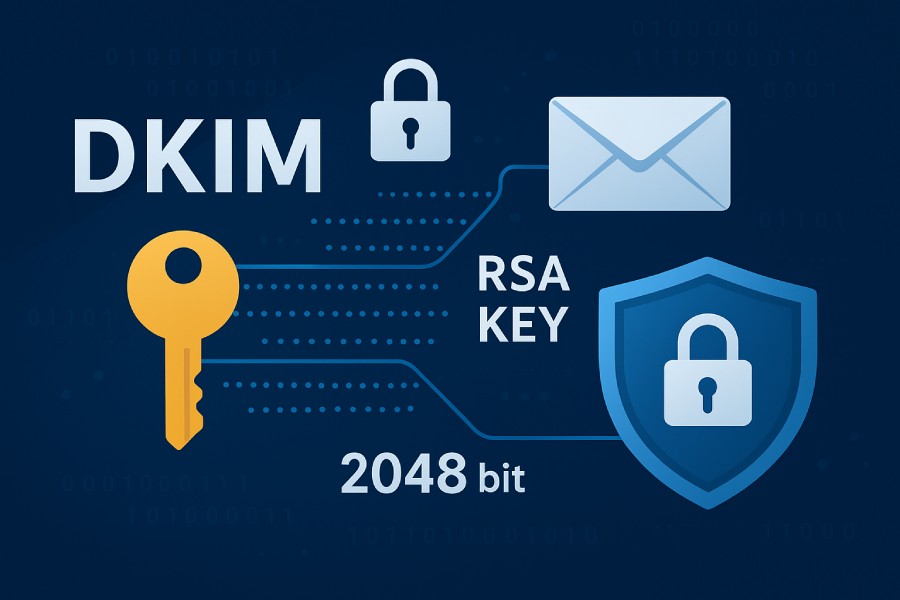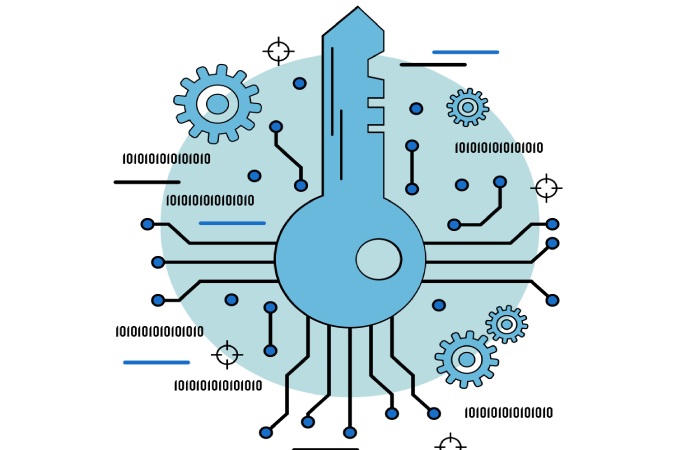DomainKeys Identified Mail (DKIM) is a cornerstone of modern email authentication frameworks, designed to bolster email security by verifying the authenticity and integrity of email messages. It operates by enabling a sender to affix a cryptographic signature, known as a digital signature, within the email headers. This signature is derived through public key cryptography, ensuring that recipients can verify the identity of the sender and confirm that the email content remains unaltered during transit.
The implementation of DKIM works alongside other email authentication standards such as the Sender Policy Framework (SPF record) and the DMARC protocol, collectively enhancing email spoofing prevention and protecting users from email phishing attacks. By associating a cryptographic signature with a specific domain via DKIM selectors and publishing the corresponding public key within a DNS TXT record, organizations improve their sender reputation and increase email deliverability across major email gateways operated by entities like Google, Microsoft, Yahoo, and Apple.
Adherence to RFC 6376, the formal specification for DKIM, mandates strict processes around digital signature generation, key management, and signature verification. These processes ensure message integrity and support secure communication between mail transfer agents (MTAs) such as Postfix and Exim, or through third-party services including Amazon SES, SendGrid, and Mailchimp.
Overview of RSA Encryption in DKIM
At the heart of DKIM’s cryptographic strength lies RSA encryption, an asymmetric encryption standard that employs a pair of keys: a private key used by the sender to generate the cryptographic signature, and a corresponding public key that recipients retrieve via DNS to verify the signature. RSA, developed by RSA Security, remains a foundational element of the public key infrastructure (PKI) in email authentication, favored for its robustness and compatibility with prevalent encryption standards.
When a message is dispatched, the private key signs a hashed representation of the email content, often produced by a hash algorithm such as SHA-256. The mechanism protects against both message tampering and unauthorized message injection. Upon receiving the message, the email gateway or MTA performs signature verification using the published public key fetched through DNS TXT record queries. Tools like OpenDKIM facilitate such verification processes within MTAs, ensuring that email headers are authentic and consistent with the sender policy.
The strength and security of the RSA key—largely determined by the RSA key length—are paramount in this process. The private key must possess sufficient entropy and size to resist cryptanalysis and mitigate the risk of key compromise, while striking a balance between security best practices and system performance.
Importance of DKIM Key Length in Security and Performance
The length of a DKIM key is crucial because longer keys enhance email security by resisting cryptographic attacks, while shorter keys improve performance by reducing computational load during signing and verification.
Importance of RSA Key Length in DKIM Operations
The RSA key length used in DomainKeys Identified Mail (DKIM) operations is a crucial factor that directly influences both the security resilience and computational efficiency of email authentication processes. The key length determines the cryptographic strength of DKIM signatures and the system’s overall ability to withstand modern cyber threats.
Security Implications of RSA Key Length
From a security perspective, longer RSA keys offer a more robust defense against brute-force attacks and cryptanalysis. As computational power advances, shorter keys become increasingly vulnerable to compromise, which can lead to authentication failures and signature forgery. By contrast, longer keys help maintain the integrity of digital signatures, ensuring message authenticity and reinforcing domain alignment and sender policy enforcement. These factors collectively enhance sender reputation and reduce exposure to email phishing and spoofing attacks.
Performance and Computational Overheads
While longer RSA keys improve security, they also impose higher computational demands on Mail Transfer Agents (MTAs) during both signature generation and verification stages. This can slow down email processing if systems are not optimized. To balance security and efficiency, email servers and gateways—configured through tools like OpenDKIM—should specify appropriate RSA key sizes that align with system capabilities and organizational needs.
DNS and Deliverability Considerations
Another operational factor to consider is the impact on DNS propagation. Larger RSA public keys stored in DNS TXT records can cause longer propagation times, potentially affecting email deliverability. Efficient DNS management ensures that authentication remains seamless even as key sizes increase.
Best Practices for RSA Key Management
To maintain long-term DKIM effectiveness, organizations should implement robust key management strategies. This includes:
- Regular key rotation to minimize the risk of compromise
- Defining key expiration schedules to ensure outdated keys are retired
- Monitoring for unauthorized access or misuse of key materials
By adopting these practices, organizations can ensure that their DKIM implementation remains both secure and performant, upholding trust in their email communications.
Common DKIM Key Lengths: 1024-bit vs 2048-bit
The two most prevalent RSA key sizes employed in DKIM are 1024-bit and 2048-bit keys. Historically, the 1024-bit key served as the standard due to its balance between security and performance. However, cryptanalysis advancements and rising computational capabilities have cast doubt on the long-term security viability of 1024-bit keys.
A 1024-bit key, while faster in cryptographic signature processing and requiring smaller DNS TXT records for public key publishing, is now considered marginal in terms of entropy. It carries increased vulnerability to sophisticated attacks that may lead to key compromise and authentication failures. Many security vendors—such as Symantec, Barracuda Networks, Mimecast, and Proofpoint—advocate for moving beyond 1024-bit keys in favor of stronger cryptography.
Conversely, the 2048-bit key stands as the contemporary best practice and has been adopted widely by leading internet companies like Google, Microsoft, Yahoo, Apple, and cloud infrastructure providers such as Cloudflare and Cisco. The 2048-bit RSA key length substantially elevates cryptographic security by increasing key entropy, thereby enhancing message integrity and email spoofing prevention capabilities.
Despite the larger key size demanding more processing resources and slightly longer DNS propagation times due to larger DNS TXT records, the improved security assurances make it the recommended key size for DKIM applications. Tools such as OpenSSL facilitate robust key generation, enabling administrators to create and manage 2048-bit RSA key pairs effectively.
Recent Trends and Recommendations for RSA DKIM Key Length
The prevailing trend in the email security landscape strongly favors the adoption of 2048-bit RSA keys for DKIM, aligning with evolving encryption standards and emerging cybersecurity cybersecurity best practices. Major industry players—Google, Microsoft, and Amazon SES among them—have updated their DKIM key size recommendations and MTA configurations to enforce minimum key sizes of 2048 bits.
Valimail, Dmarcian, and other email security analytics providers emphasize the importance of upgrading vendors’ DKIM keys to the 2048-bit standard to maximize resistance to cryptanalytic attacks and avoid authentication failure events that can adversely affect sender reputation and email deliverability.
The DMARC protocol integrates seamlessly with DKIM and SPF to provide domain alignment checks, which depend heavily on the robustness of cryptographic signatures and key management. Regular key rotation, timely key expiration schedules, and vigilant key verification practices help mitigate risks associated with key compromise and DNS TXT record stale data.
Organizations deploying DKIM should utilize key generation tools such as OpenSSL to create secure private keys with high entropy and ensure consistent synchronization within their public key infrastructure. MTA configuration using OpenDKIM or similar software should explicitly specify 2048-bit keys wherever supported, and transitional strategies for replacing legacy 1024-bit keys must be implemented with attention to DNS propagation timelines to avoid email delivery interruptions.
In conclusion, the convergence of security best practices, the urgency of combating sophisticated email phishing techniques, and compliance with updated encryption standards collectively drive the widespread endorsement of 2048-bit RSA key lengths in DKIM implementations across the industry, promoting stronger email authentication and enhanced sender policy enforcement.
Potential Risks of Using Shorter DKIM Keys
Understanding DKIM and RSA Key Length
DomainKeys Identified Mail (DKIM) relies on public key cryptography to verify email integrity and prevent spoofing. The RSA key length, specified in bits, plays a critical role in the cryptographic signature process. Historically, many domains used a 1024-bit key for DKIM signing. However, this key size is increasingly vulnerable to cryptanalysis, where attackers exploit computational advances to potentially derive the private key.
Risks of Using Shorter DKIM Keys
Key Compromise
Using shorter keys, such as 1024-bit, exposes domains to the risk of key compromise. An attacker who obtains the private key from the public key in the DNS TXT record can forge digital signatures.
Email Spoofing and Authentication Failure
Compromised DKIM keys allow unauthorized entities to send spoofed emails that bypass SPF and DMARC defenses. This can lead to:
- Authentication failure
- Damaged sender reputation
- Increased susceptibility to phishing attacks
Best Practices for DKIM RSA Key Length
Minimum Key Length Recommendation
Security experts now recommend a minimum RSA key length of 2048-bit for DKIM. This key size provides exponentially greater resistance to cryptanalysis, making it much harder for attackers to compromise the key.
Industry Adoption
Major industry players, including Google, Microsoft, and Yahoo, have either enforced or strongly recommended 2048-bit DKIM keys. Leading email gateways like Barracuda Networks and Mimecast also adopt this standard to:
- Enhance email deliverability
- Protect against unauthorized MTA manipulation
Compatibility Considerations Across Email Servers and Clients
While upgrading to a 2048-bit key is advisable for enhanced security, organizations must consider compatibility across various email servers and clients. Some legacy MTAs, such as older versions of Postfix or Exim, and certain smaller or embedded mail clients may not fully support larger key sizes or may experience delays in DNS propagation due to increased DNS TXT record size.
Additionally, interoperability with popular email service providers like Amazon SES, SendGrid, and Mailchimp is generally seamless with 2048-bit keys, given that most major providers—including Microsoft and Apple—support stringent encryption standards and key size recommendations as outlined in RFC 6376. However, careful MTA configuration and DKIM selector management are necessary to avoid failed key verification or signature verification issues, which could affect email deliverability adversely.
Organizations deploying OpenDKIM or similar key management solutions should also verify that their key generation tools, often based on openssl, generate keys with sufficient key entropy to prevent cryptographic attacks. In rare cases, older email clients or gateways might require fallback mechanisms, but given the increasing emphasis on email security against phishing and spoofing by entities like Cisco and Proofpoint, adherence to modern encryption standards is paramount.
Best Practices for Generating and Managing DKIM Keys
Effective DKIM Key Management: Key Points
- Use Strong RSA Key Lengths
- Generate DKIM keys with a minimum of 2048 bits using tools like OpenSSL.
- Ensures robust cryptographic signatures and compatibility with secure hash algorithms such as SHA-256.
- Generate DKIM keys with a minimum of 2048 bits using tools like OpenSSL.
- Ensure High Key Entropy
- Keys must be unpredictable to resist brute-force attacks.
- High entropy strengthens security and prevents unauthorized key recovery.
- Keys must be unpredictable to resist brute-force attacks.
- Publish Public Keys via DNS TXT Records
- Associate the public key with a DKIM selector in your DNS.
- Facilitates key rotation without disrupting email delivery.
- Associate the public key with a DKIM selector in your DNS.
- Follow Proper Selector Naming Conventions
- Clear and consistent naming helps manage multiple keys efficiently.
- Simplifies troubleshooting and ensures seamless email authentication.
- Clear and consistent naming helps manage multiple keys efficiently.
- Monitor DNS Propagation
- Verify that public keys are properly published and propagated.
- Prevents authentication failures due to outdated or incorrect DNS records.
- Verify that public keys are properly published and propagated.
- Implement Key Expiration Policies
- Set regular key rotation schedules to reduce risk of compromise.
- Expired keys should be revoked and replaced to maintain DKIM integrity.
- Set regular key rotation schedules to reduce risk of compromise.
- Routine DKIM Audits
- Regularly check DKIM settings for misconfigurations or signs of compromise.
- Ensures domain alignment and avoids sender policy violations.
- Regularly check DKIM settings for misconfigurations or signs of compromise.
- Leverage Key Management Platforms
- Tools like Dmarcian or Valimail provide centralized key management.
- Assist in compliance tracking, monitoring, and maintaining sender reputation.
- Tools like Dmarcian or Valimail provide centralized key management.
How to Update and Rotate DKIM Keys Securely
DKIM Key Rotation: A Critical Security Practice
Key rotation is a vital aspect of DKIM implementation that enhances email security and minimizes the risks associated with key compromise. Proper rotation ensures that cryptographic keys remain secure and email authentication remains reliable.
Generating a New Key Pair
Choose Strong Key Lengths
Begin by generating a new DKIM key pair. For optimal security, use 2048-bit or higher keys to resist brute-force attacks and cryptanalysis.
Publish the Public Key
Publish the new public key in your DNS TXT record under a new DKIM selector. Keep the existing key active during this period to allow a seamless transition.
Updating Mail Transfer Agents (MTA)
Configure Your MTA
Update your MTA (Postfix, Exim, OpenDKIM, or others) to sign outgoing emails with the new private key.
Dual Signing for Transition
During the overlap period, outgoing emails may be signed with both old and new keys. This ensures that receiving servers can verify signatures without authentication failures while DNS propagation completes.
Verifying and Retiring Old Keys
Check DNS Propagation
Use verification tools provided by Proofpoint, Cloudflare, or Symantec to confirm that the new DKIM public key has propagated across DNS.
Retire the Old Key
Once verification is complete, safely remove the old key to prevent misuse or compromise.
Establishing Regular Rotation Practices
Recommended Rotation Intervals
Rotate keys every 6 to 12 months to reduce exposure to cryptanalysis and potential entropy degradation.
Implement Monitoring and Alerts
Automate monitoring and alerts to detect any key compromise, ensuring your DKIM setup continues to protect email integrity and sender reputation.
Future Outlook: Evolving DKIM Standards and Key Lengths
The rapid evolution of encryption standards, influenced by security research and the expanding threat landscape of email phishing and spoofing, suggests that DKIM standards will continue to evolve. Emerging legislation and updated RFCs may recommend or mandate the adoption of even larger RSA key lengths or alternative cryptographic schemes that surpass the current 2048-bit key size.
Research into quantum-resistant cryptographic signatures may influence future protocols that supplement or replace existing RSA-based DKIM implementations. Meanwhile, major cloud providers like Google and Amazon SES, security vendors such as Barracuda Networks and Mimecast, and open-source initiatives like OpenDKIM are actively monitoring advances to adapt their authentication frameworks accordingly.
Furthermore, improvements in DKIM selector management and automation in key rotation and verification processes will likely enhance user experience for domain administrators, reducing the operational overhead while maintaining stringent email security standards. Ultimately, organizations dedicating resources to robust key management practices and adhering to industry best practices will be well-positioned to navigate the shifting landscape of email security.
FAQs
What is the recommended RSA key length for DKIM today?
The industry consensus recommends using a 2048-bit RSA key for DKIM to ensure a strong cryptographic signature that resists modern cryptanalysis and supports email security best practices.
Why is key rotation important in DKIM?
Key rotation helps mitigate risks from key compromise by periodically replacing private and public key pairs, ensuring ongoing protection of message integrity and preventing email spoofing.
Can smaller DKIM key sizes cause email deliverability issues?
Yes. Using shorter keys such as 1024-bit keys may lead to authentication failure, damaging sender reputation and increasing the chance that emails are flagged as phishing or rejected by major providers like Google and Microsoft.
How does DKIM work alongside SPF and DMARC protocols?
DKIM, SPF records, and DMARC protocol function together to authenticate emails, ensuring sender policy adherence and domain alignment, thereby enhancing protection against email spoofing and phishing attacks.
How do I publish my DKIM public key?
The public key is published in your domain’s DNS as a TXT record using a DKIM selector, which is then used by receiving mail servers for signature verification as outlined in RFC 6376.
Are all email servers compatible with 2048-bit DKIM keys?
Most modern MTAs—including Postfix, Exim, and services like Amazon SES and SendGrid—support 2048-bit keys, but careful MTA configuration and DNS management are essential to prevent verification issues.
Key Takeaways
- Shorter DKIM keys (e.g., 1024-bit) present significant security risks, including susceptibility to cryptanalysis and key compromise.
- A 2048-bit RSA key length is the current key size recommendation to ensure email authentication remains robust against evolving threats.
- Comprehensive key management including secure key generation, public key publishing via DNS TXT records, and scheduled key rotation is vital for maintaining email security.
- Compatibility with major email servers and clients generally supports 2048-bit keys, but careful configuration of MTAs and selectors is necessary.
- Future enhancements in DKIM standards will likely focus on stronger cryptographic algorithms and automation to improve protection against email phishing and spoofing.







